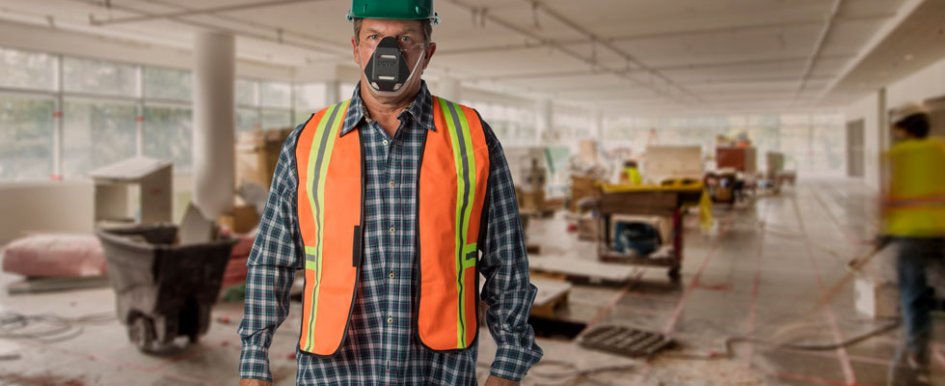
The air we breathe is a fundamental survival necessity, yet those who spend large quantities of time outside don’t give the quality of the air much thought. We instead operate with the belief that if we’re outside, fresh air is abundant and exactly what is required for optimal health.
As a mostly outdoor profession, construction crews and trade professionals have long taken comfort in the theory that working outdoors provides protection from respiratory concerns, believing they are operating in safe environment. What then are construction industry professionals to do when the air surrounding them is contaminated by elements that threaten their health?
The Hidden Dangers of Airborne Contaminants to Construction Workers' Health
Often colorless and odorless, those contaminants can be hard to detect. Yet prolonged inhalation of chemicals, silica, wood dust, chalk or even mold can result in long-term illnesses such as chronic obstructive pulmonary disease (COPD), mesothelioma (caused by exposure to asbestos), silicosis (lung scarring caused by breathing silica dust) and others.
Those working in tight indoor quarters with materials that off-gas, contain harmful volatile organic compounds (VOCs) or emit toxic chemicals put themselves in harm’s way. The air we breathe seems to be in jeopardy, possibly signaling a need for a degree of filtration to negate the effects of pollutants and contamination.
Invisible Threats
Drought-ridden areas across California, Nevada, Washington, Oregon, Utah and Canada have burned for several months, negatively impacting the air quality across a large portion of North America, prompting statewide environmental protection agencies to raise alerts for residents to remain indoors and avoid going outside until polluted air resolves.
According to Professor Michael Greenstone of the University of Chicago who in conjunction with colleagues developed the Air Quality Life Index (AQLI), which converts air pollution levels into impact on life expectancy, “air pollution is the greatest external threat to human health on the planet.”
The World Health Organization (WHO) echoed the same sentiment, suggesting that air pollution is “one of the biggest environmental threats to human health.” Of particular concern is particulate matter (equal to or smaller than 10 and 2.5 microns; defined as PM2.5), capable of penetrating deep into the lungs and bloodstream. Prolonged exposure to wildfire smoke, specifically, comprised of both particulate matter, soot and dangerous toxic gases, can have both detrimental and far-reaching impact, contributing to lung cancer, heart disease and an overall higher chance of early death. In fact, long-term smoke exposure results in 6,300 additional deaths each year. The increase in deaths has been directly linked to wildfire smoke.
COVID-19's Impact to Construction Worker Health
The onset of COVID-19 did little to impact those who work in homebuilding and construction. Deemed “essential” workers, contractors and tradespeople continued to show up in force — maintaining a full-speed-ahead approach. Many continued to work in both closed spaces and near counterparts with minimally implemented mitigation measures to reduce, prevent or stop COVID-19 spread, ultimately adding to their level of risk.
Dr. Jeffrey Klausner, a professor at UCLA’s School of Public Health and infectious disease specialist, shared research indicates that construction workers are at higher risk of severe illness from COVID-19 due to of age, underlying medical conditions and other risk factors, such as a high rate of smoking. Conducted in Los Angeles from August to October 2020, the research study revealed that construction workers had the highest case rate of infections out of any other industry — higher than even health care workers.
These results added fuel to data collected previously in 2018, which reported that 20% of construction workers have some form of respiratory disease such as COPD or asthma — which further increases their risk of serious complications from COVID-19. Although it is difficult to accurately pinpoint the exact number of COVID-19 cases and deaths due to the lack of mass testing and transparent reporting, existing data reveals that construction industry professionals have been hit hard. In Colorado, construction workers made up the highest portion of COVID-19 deaths out of all industries, accounting for 111 deaths or 12% of the total 5,921 working-age deaths reported by the state.
Respiratory Health Toolkit
Convincing hardened contractors and tradespeople to don a respirator mask for respiratory protection has its own set of challenges — even though a properly fitted, high-quality respirator mask remains the most inexpensive and effective way to protect against the harmful effects of air contaminants and pollution.
The Centers for Disease Control and Prevention has also recommended against using cloth, paper or surgical masks in construction environments as they are ineffective at trapping fine particular matter and harmful contaminants. N-95 or P-100 masks are the standard for filtering contaminants yet are useless if not properly sealed to the face.
The construction industry has reached a pivotal crossroads — one where considerations should be given to respiratory safety and its complexities. The intersection between burning wildfires (and resulting toxic smoke), the aftermath of extraordinary weather events causing dangerous mold, the resurgence of COVID-19 and prolonged exposure to workplace toxins and fumes highlights the need for improved education and support for respiratory wellness in the construction industry.
Mandates and protocols for safety are an important step, however long-term respiratory health begins with simple precautions — proper respirator mask wear and indoor air filtration — to protect the health of team members working inside and out.
